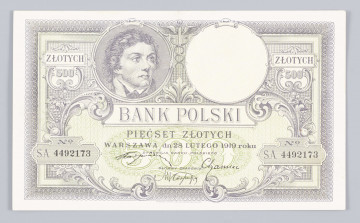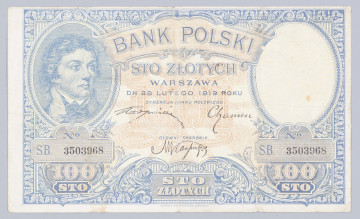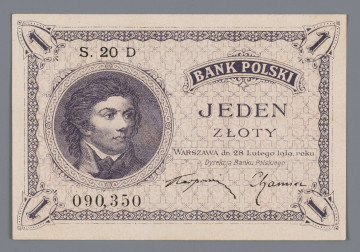
500 zlotys
1919
National Museum in Lublin
Part of the collection: Paper money during the Second Polish Republic
The history of Poland abounds in events which caused the abandonment of the most important activities or led to their implementation in a changed reality. As far as paper money is concerned, one of the most vivid examples of the complicated history is the 1000-zloty banknote of 1919. As in the case of other denominations, the decision to issue it was taken on 28 February 1919. The preparations for the issue were handled by the Polish National Loan Fund, established on 9 December 1916 by the German occupational authorities. Despite that, the banknote features Bank Polski – an institution which was to be established only in five years' time – as the issuer. Waterlow & Sons Ltd was commissioned to print some denominations, including the 1000-zloty ones. We do not know the size of the order. All we know is that in 1920, a batch of finished banknotes, packed in crates, was to be shipped to Poland. Due to the ongoing Polish-Bolshevik War, London dockers, under the influence of Bolshevik agitation, threw some of the crates into the water, believing that they contained armaments for the Polish Army. In this way, 4,000 notes with a nominal value of 4,000,000 zloty were destroyed. The rest of the banknotes found their way to Poland, but no decisions were made about them until 1924. At this time, the role of circulation money was played by the steadily weakening Polish mark. It was not until Władysław Grabski became Prime Minister and reforms were introduced to improve the Polish economy that the decision was made to introduce banknotes, the printing of which had been commissioned five years earlier. Due to the changed market realities and the high exchange rate of the zloty because of the reform, the 1,000- and 5,000-zloty banknotes were not put into circulation. It turned out that their introduction was unjustified. Thus, these banknotes continued to rest in boxes. In September 1939 they were evacuated to the east, to the Dubna Castle. After the Red Army occupied the area, knowledge of their disposition was lost. It would seem that this marked the end of their history, but not in the case of the 1000-zloty banknotes. The preserved copies bear traces of wear in the form of scuffs and folds. The discovery of a hidden banknote next to a victim of the Katyń massacre has led to the assumption that the banknotes entered circulation during the war as officers' pay.
Leszek Poniewozik
Author / creator
Dimensions
cały obiekt: height: 173 mm, width: 110 mm
Object type
paper money
Technique
Material
paper
Creation time / dating
Creation / finding place
Owner
The National Museum in Lublin
Identification number
Location / status

1919
National Museum in Lublin

1919
National Museum in Lublin

1919
National Museum in Lublin
DISCOVER this TOPIC
National Museum in Lublin
DISCOVER this PATH
Educational path